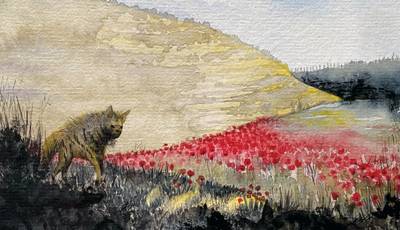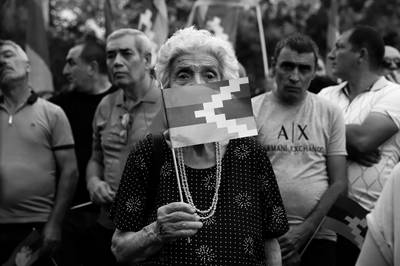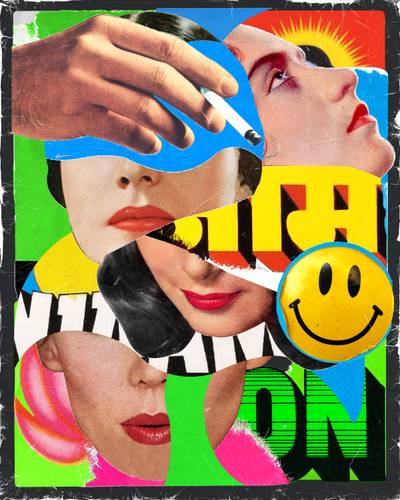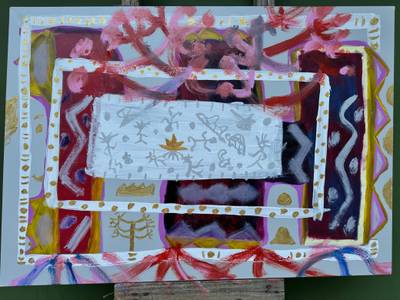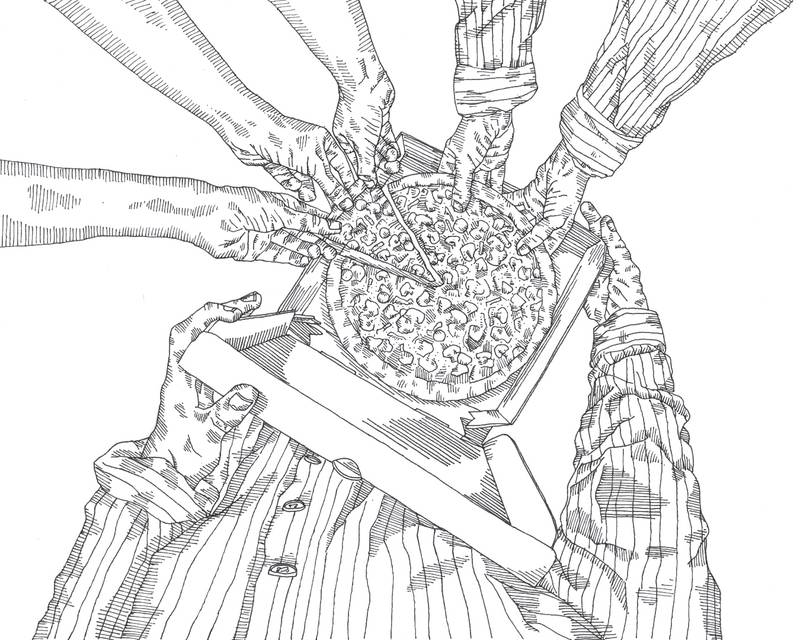

Illustration by Madeleine Åberg Hellberg
Jonatan Habib Engqvist is a curator, author and occasional teacher. He has worked extensively with residences, curated numerous exhibitions, biennials and festivals and his texts have been published widely in books and catalogues in several different languages around the world.
Egle Oddo is a visual artist interested in operational realism, meant as the presentation of the functional sphere in an aesthetic arrangement and its inter-relations. Her work is present at international biennials, museums and relevant institutions, as well as cutting edge and independent alternative spaces and events.
Dr. Timo S. Tuhkanen (they/them) is an Omani born artist-composer and academic working at the intersection between contemporary music, art, and research on the historical and cultural aspects of touch. Currently based in Helsinki Timo is the founder of experimental publishing house Pteron Press, the director of Myymälä2 gallery, Affiliated Researcher at the Department of Music, University of Turku, Artistic Researcher at Angewandte University of Applied Arts Vienna, and is currently the Principal Investigator and founder of Microtonal Music Studios.
For almost a century, the Nordic region has been a flagship model for international arts funding. It is a tradition of a public funding system where a rotating group of peers/experts decides on the distribution of funds to artists through applications or open calls. It is not the best, but it is one of the least bad funding systems in the world because, compared to other countries, it socialises the funding, making it accessible to a wider group of people. In an environment where hybrid forms of semi-public institutions keep emerging, we can’t help but express concern about the centralisation of power these institutions advocate for. This article addresses the current trends of financial cuts underway in the arts sector in Finland, trends that are paired with classism, social discrimination, racism, and the exclusion of non-Finnish workers. In many ways, international art funding in the Nordic region has previously been peer oriented, structured around dialogue, allowing the funding to follow the development of the field. This specific aspect has been at the core of the Nordic model of art funding’s success2. Are we now witnessing a sale of the Nordic model to the highest bidder?
Let’s give this hypocrisy the benefit of the doubt
In the Nordic countries, the normalisation of neoliberal ideology, strategies and managerialism —described by Mark Fisher as ‘capitalist realism’— has started to take over the art field in its entirety, down to the tiniest art initiative. As Fisher writes, “with the triumph of neoliberalism, bureaucracy was supposed to have been made obsolete… [but] instead of disappearing, bureaucracy has changed its form, and this new, decentralised form has allowed it to proliferate.”3 As a result, the logic of economic growth has encroached on all aspects of work and life, affecting institutions in all fields—education, art, and activism—which now spend a significant amount of their time labouring with endless applications and self-assessments.
In this ecosystem, arrays of hybrid- or semi-public organisations that have gone from being public organisations to becoming private foundations are no exception (check the footnote to read on a few examples).4 Despite their efforts to critically shake their own biases,5 in recent years, we have seen them sidelining the concrete implementation of the principles of equity they declare,6 preferring instead to flex and expand their power. This is devised at the expense of social mobility and creates an environment of elitism, or exclusive inclusiveness, if you will, engulfing projects and manifestos of fairness. At the margins of this environment, grassroots organisations actually do the job, keeping cohesion, filling the gaps in the fabric of society, and implementing accessibility with their scarce resources.7
Such hybrid-public organisations wearing politically correct make-up could instead cultivate the transversal diversity offered by the art field and its actors. This would require stepping down from the pedestal they keep busy building for themselves and cultivating the delicate ecology of independent grassroots organisations, which actually implement the possibility for artists and curators from less privileged social classes to access work opportunities. We wish to offer a modest selection of cases where we see some doors opening and some closing and the possibility for real change being invited or excluded. Yet, the cases described here are examples of something much more disconcerting yet insightful.
The change in the guidelines is a perfectly aligned choice with the new Finnish far-right government taking office in 2023, with regulations implementing discriminatory conditions for foreign workers and students. Therefore, it cannot be treated as an isolated case or as a coincidence but must be read in the context of a rising implementation of politics of exclusion in Finland and in the Nordics at large.
The Politics of Exclusion
On February 28, 2023, the Board of Frame Contemporary Art Finland,8 under the advice of Director Raija Koli, made an apparently uneventful change to their guidelines: “As a general rule, the grant will be paid to foreign beneficiaries (natural persons and entities) only on presentation of a report on the use of the grant in accordance with the grant guidelines after the implementation of the supported project.”9 The change in the guidelines is a perfectly aligned choice with the new Finnish far-right government taking office in 2023, with regulations implementing discriminatory conditions for foreign workers and students.10 Therefore, it cannot be treated as an isolated case or as a coincidence but must be read in the context of a rising implementation of politics of exclusion in Finland and in the Nordics at large. Frame Contemporary Art Finland constitutes one mere example of similar cases that recently caught our attention, and it will be used in this article as a case to expose structural imbalances.
What is important to talk about are the results of this change in guidelines. This change, only directed at foreign beneficiaries, natural persons and entities, creates a profound disparity between them and Finnish beneficiaries. To be clear, while Finnish beneficiaries will receive their grant at the beginning of their project, ready to be spent after they sign the contract, the foreign beneficiaries will need to advance the expenditure, send a report, and await approval before they receive the grant. This changes the nature of the funding structure in a way that divides people first between those who are from Finland and those who are not, and importantly, also between those who already have capital and those who do not.
In economic terms, this change means that foreign grassroots organisations and professional individuals who do not benefit from stored capital to advance expenses will not be able to apply under these new conditions. It means that the most vulnerable curators, artists, and institutions (because they are also economically vulnerable) will, in effect, be dissuaded from applying. It means that artists and organisations in Finland that network and create collaborations away from financial capital will lose these modes of artistic work.
Ramifications
So, what does this mean in terms of the ethics of communication, or at large, in political terms? The institution seems eager to communicate that they feel entitled to treat foreign beneficiaries differently without having to calculate the social impact of their choice, the fractures they create in international cooperation, the message they are sending to institutions, especially in the global south, as well as the type of hospitality they intend to reserve for them.
How will this exclusion be visible? How can someone who is actively discouraged from applying through such system disparity even be tracked or counted? How can the politics of exclusion be made visible in statistical terms if the one excluded is by system design, not part of the statistics?
The problem at hand intertwines questions of social class and a nationality-based discriminative factor, the former being the bigger elephant in the room of the art sector. With a long and detailed letter sent in March 2023, Oddo asked the question to the Board and to Koli: “Even if the measure is disgraceful because it will surely accelerate class-based exclusion, why has it not been implemented equally for Finnish beneficiaries, mitigating at least part of the ostracism?”
How will this exclusion be visible? How can someone who is actively discouraged from applying through such system disparity even be tracked or counted? How can the politics of exclusion be made visible in statistical terms if the one excluded is by system design, not part of the statistics?
To date, the answer delivered by the chairperson of the board through Koli seems to state that the board of Frame does not need to take this into account.
It is still unclear precisely what and whom the cuts in Finnish cultural funding will target, but the Finnish Artists Association believes that they will target small organisations and associations while leaving out the export and promotion of Finnish art and artists abroad.11 It would indeed be a happy coincidence for the organisations that have advocated for more funding from the Ministry in the name of a constellation of small institutions to see their funding preserved while the small institutions suffer the cuts. Again, this would be put into perspective since most of the funding is used for the promotion of their in-house created content instead of supporting independent artists, curators, and grassroots institutions.
From Promotion to Production
Sending people to exotic places is as cheap as it is good for the self-worth of institutions promoting Finland. Not taking risks, only funding exhibitions and participation in large financially viable events abroad, often those with hefty cultural and financial capital of their own, does not necessarily mean that such funded artists create any meaningful long-term relationships with the local art scenes.
Collaborations between grassroots art organisations not only create a unique ecology and network, forming the backbone of a large number of artists in many countries, but these relationships tie together a heterogeneous flow of people and organisations that allow for multiple and diverse types of artistic and financial ecologies to flourish.
The kind of networks that concern us here12 do not necessarily ensure fast turnovers, immediate results, or press coverage in prestigious western anglophone Art Forum-like journals but are indicative of sustainable modes of practice that take time. There are numerous examples of grassroots collaborations that, with sustained timelines of decades rather than weeks, have led to solid international careers within and beyond the global mainstream of contemporary art for many of their participants. We could perhaps compare these networks to the strong international cooperation and alliances that have formed over the years through the models of open-ended residency programmes and exchanges for artists and curators, who receive both time and economic compensation without demands for production or reporting.13
The parvenue-foundations, which historically operated as mediators, relying on their respective missions to receive public funding and then make it accessible to others, seem to have inverted this tendency by increasingly withholding the funding for in-house use. They seem eager to become production houses, where instead of creating space for other professionals and institutions to access funding and carry out projects, they produce and market in-house projects under the flag of the nation-state, creating opportunities for their own staff and a restricted circle of adepts.
This brings us to the next level of inquiry. When challenged on their mission, bylaws, ethics, and governing structure, we have noticed that especially those hybrid institutions,14 which have drifted from a specific public realm with a clear set of duties subject to public scrutiny into becoming private foundations with no specific duties aligned with a public mandate, are less inclined to incorporate meaningful institutional self-critique in their practice, besides amicable but often non-committal statements. This change is not only happening in the visual arts but in other fields as well. For example, the music royalty collecting association in Finland, Teosto, is currently negotiating its change into a foundation with deep implications for artists’ livelihoods that remain unattended and unanswered. It is important to differentiate such nouveau-foundations or parvenu-foundations from historical private foundations that started their existence as such. While the historical private foundations15 never had the ambition to rely on public funding to realise their own projects, mandates, and goals and yet seem very generous in forwarding their funding to independent artists, curators and organisations, the parvenue-foundations, which historically operated as mediators, relying on their respective missions to receive public funding and then make it accessible to others, seem to have inverted this tendency by increasingly withholding the funding for in-house use. They seem eager to become production houses, where instead of creating space for other professionals and institutions to access funding and carry out projects, they produce and market in-house projects under the flag of the nation-state, creating opportunities for their own staff and a restricted circle of adepts. While titling themselves (Finnish-, Danish-, Swedish-, etc.), they use a national attribute to monopolise an image not only of authority but of connectedness to the state or seeming to be public institutions, without this factually being true.16 This is problematic on several fronts in terms of centralisation of power, transparency, and conflict of interests and is the typical behaviour of gatekeeping. It is crucial to note how deeply this change is connected to strategically converting temporary positions to permanent ones while centralising decision-making power within the cultural sector.
The shift to prioritising production over promotion is not only a tendency of such hybrid organisations. In Finland, a collaborative network facilitating the mobility of employees has been created between organisations like Frame and the Finnish Institutes around the world, thereby creating an overarching organisational framework that instates competition between seemingly national institutes and the art sector, providing the institutes with a clear advantage through their affiliation with the title “Finnish”. Through the cementing of such alliances and superstructures, grassroots organisations today no longer seem to be competing for funding just with each other but with the image of the nation-state itself, an image that is fallacious and illusory upon closer inspection but, for all intents and purposes, remains a real and firm deterrent for competition.
Rather than creating possibilities, opening up collaborations and networks for artists and organisations, and allowing them the agency to decide for themselves how and whom to work with, the mandate is delegated to these actors to curate bodies and choose international programming and cooperation into the morphed image of the state. Would any grassroots organisation do the same, calling themselves “The Finnish Institute of Contemporary Art”, for instance?
The Larger Picture
Although the focus of this text is on the Finnish case, the tendencies described above can be found in several organisations in Europe. For example, the Swedish Arts Grants Committee’s International program for applied and contemporary art, Iaspis, has quietly undergone several structural transformations where a previously temporary director position was made permanent, only to be later removed during a leave of absence, letting “content” production delegated to external freelancers, under the title “guest curator”. With the proposed merging of the Committee and the national culture council (Kulturrådet), the risk of furthermore taming, if not crippling, the institution is apparent.
Going further south, one can find a completely different reality. Italy likes to market itself as an art wonderland, but it is one of the most modest countries in terms of public and private support for contemporary living artists. Finally, in 2017, the Italian Council was constituted under the Ministry of Culture, and only in 2019 did it start supporting individual artists, curators, and grassroots art organisations.17 Although the Italian Council has very limited resources compared to the great demand, it has been welcomed as a rock bottom change in an otherwise financial desert for precarious artists. In such a landscape, projects like MAAM18 and Macro Asilo19 are particularly fit to depict that a reverse tendency is possible, especially in class elitism.
As long as it existed, the Macro Asilo project has transformed a typical gatekeeping public institution, such as the Contemporary Museum of the City of Rome, into a living organism where artist residencies, events, exhibitions and myriads of contents have been produced and delivered through collective self-management, demonstrating that there is no necessity for an elitist structure; it is a myth. Because of its tremendous success, the project was shut down before time.
Defined as a superplace by Marc Augé, MAAM is an inhabited museum, housing more than 60 families and countless artworks since 2011. It merges the function of instigating and preserving contemporary art made by living artists with the necessity for people in vulnerable financial conditions to have a house, while their agency is reflected in the aesthetics of the space.
As long as it existed, the Macro Asilo project has transformed a typical gatekeeping public institution, such as the Contemporary Museum of the City of Rome, into a living organism where artist residencies, events, exhibitions and myriads of contents have been produced and delivered through collective self-management, demonstrating that there is no necessity for an elitist structure; it is a myth. Because of its tremendous success, the project was shut down before time.
In both projects, the available resources have been distributed horizontally, creating benefits and profit for everybody, while the figures of the museum director and the star curator have been repurposed, making space for multiple voices.
As a counter-example to the aforementioned hybrid organisations, the work of ruangrupa in documenta fifteen went exactly in the opposite direction. ruangrupa’s idea was to delocalise central funding from Europe and distribute it to places where precarious organisations and individuals actually need it in order to produce works.20 They managed to orient their contract with documenta and release that money across several collectives globally. Although there were problems related to uniformity in accounting criteria and reporting became more laborious, the process remained transparent.21 Most importantly, financial plans, budgeting and reporting were accepted by the board of documenta, who stated at the end of the project that the books were “in the black”, meaning that they were profitable, not only acceptable but profitable. What is very important is that this means that the model ruangrupa created is more profitable than just handing over the money to a small elite, because it had a much wider social impact. It was a generous and ethically impressive undertaking. An ethics of artistic support that shows unprecedented coherency talks the talk and walks the walk.22
In the dimension of equity-realism, it is necessary to break the trend leading towards a further entrenching of elitism or exclusivity. In a time of profound recession and social inequality, it seems economically and socially urgent that organisations and institutes, those that use their association with the state and those who choose a path less oriented towards national promotion, learn from the actual experimentation on financial models and choose to distribute and support the diverse economic ecologies of grassroots art organisations and independent artists. If this were considered by executive directors and boards or not, what remains is that if the tendency towards centralisation and discrimination is accepted, the Nordic art scene will lose its vitality and become uneventful, if not completely irrelevant. And this would only lead to being used as a justification for further cuts in the cultural sector.
Is dialogue still possible?
Institutional critique is not a one-of-a-time gig, an externalised service, or a report that makes the director’s desk to be dismissed as a utopian dream. Institutional critique needs continuity in its pursuit and a long-term commitment to its implementation. Only this way will there be change. The most vital truth is that in the Nordic countries, this seems possible and viable to an impressive degree. Creating space for implementing such changes requires effort, moving transversally in all places of soft and hard power. It requires that those now sitting at their director’s desks stop making excuses about their vulnerability and fight against the erosion of a model that has so far created a particularly vibrant and dynamic grassroots art scene, albeit with much work still to do in terms of inclusion. It requires them to see and act beyond the nationalistic politics of exclusion and the commercialisation of art, and for them to support and finance critical, reflexive, and dangerous art projects. Furthermore, it requires projects that actually matter, where collaborations between peers become essential to the site and its neighbours, where sustainability is not only a marketing word but a physical and mental reality that allows for generational human wealth to accumulate in knowledge, hospitality, and care for everyone, rather than ensuring the long-term contract just for the few.
What we present here are two problems: the nationality and class-based exclusion of certain service recipients by designing a system that is not accessible; and the hybridisation of institutions that benefit from large state support but do not collectivise their resources, preferring to keep it for their in-house projects.
To elucidate the problem in pragmatic terms, our case of choice has been the change of guidelines in Frame Finland and its tendency to fund more in-house projects while dismissing the open call procedure.23 In order to have more transparency in this matter, the following questions are thus addressed to Frame’s board of directors, head of programme, and director to be answered. As these questions are for all the boards and executive directors of those organisations that presently benefit from the hybrid status we have pointed out in this article:
- How much of your financial support and your power is derived from your association with the state?
- How much of that power and support is collectivised with less privileged actors, natural persons and organisations? Give concrete examples.
- Do you imagine that you can ignore the ethical, non-written mandate of fairness deriving from your association with the state or the public domain, even if your present bylaws do not specifically require you to do so?
- By occupying your position in the organisation, who do you imagine that you are serving?
- If you are ready to implement concrete change, what are the main areas where your energy needs to be invested?
The text was sent to Frame Contemporary Art Finland by the editors before publishing; the response to the authors can be found here.
